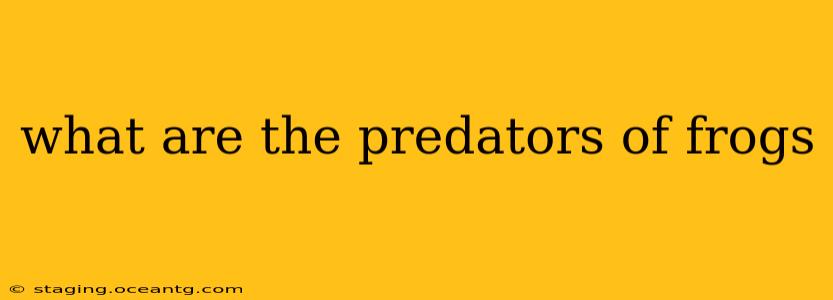Frogs, with their vibrant colors and characteristic leaps, are a fascinating part of the ecosystem. But their seemingly carefree existence belies a constant threat from a surprisingly diverse range of predators. Understanding these predators is crucial for appreciating the delicate balance of nature and the challenges frogs face in the wild. This article will explore the many animals that prey on frogs, categorizing them for clarity and delving into specific hunting strategies.
What animals eat frogs?
This question is best answered by breaking down the predators into categories based on their size and hunting methods. The list is extensive, reflecting the frog's position as a vital link in many food chains.
Birds:
Many bird species include frogs in their diet. Larger birds, like herons, egrets, and storks, are adept at snatching frogs from the water's edge or even from within shallow water. Smaller birds, such as kingfishers and some hawks, will also opportunistically hunt frogs. Their sharp talons and beaks make quick work of even larger frog species.
Reptiles:
Snakes are arguably the most significant reptilian predators of frogs. Many snake species have evolved specialized adaptations for hunting amphibians. Some snakes, for instance, possess venom specifically effective against frogs, while others rely on constriction. Lizards, particularly larger species like monitors, also prey on frogs, using speed and powerful jaws to capture their prey. Crocodiles and alligators, while not solely frog-eaters, will readily consume frogs when the opportunity arises, especially smaller individuals.
Mammals:
Various mammals, ranging in size from small rodents to large carnivores, will eat frogs. Smaller mammals, like shrews and weasels, might focus on tadpoles or smaller frogs. Larger mammals, such as raccoons, badgers, foxes, and even some cats, will prey on adult frogs, often targeting them at night. Otters are also skilled frog hunters, utilizing their aquatic abilities to ambush frogs in their natural environment.
Fish:
Larger fish, especially those found in the same habitats as frogs, are significant predators. Bass, pike, and catfish are known to consume frogs, particularly tadpoles and smaller frogs. They ambush their prey, using their swift movements and sharp teeth to secure a meal.
Amphibians:
Believe it or not, some amphibian species are cannibalistic, with larger frogs sometimes preying on smaller ones or even their own tadpoles. This behavior is often influenced by factors such as food scarcity or population density.
Insects:
While frogs are predators themselves, they're not immune to attack from insects, particularly in their tadpole stage. Certain insect larvae and predatory aquatic insects can pose a threat to tadpoles.
What are some common frog predators in specific habitats?
The specific predators of frogs vary greatly depending on the frog species and its habitat. A rainforest frog will face a different set of predators than a desert frog. For example:
- Tropical Rainforests: A greater diversity of predators exists, including tree snakes, various bird species, and large lizards.
- Temperate Zones: Snakes, larger birds, and mammals like raccoons and foxes are common predators.
- Aquatic Habitats: Fish, larger amphibians, and aquatic birds are the primary threats.
What defenses do frogs have against predators?
Frogs have evolved various defense mechanisms to avoid becoming prey. These include:
- Camouflage: Many frogs have coloration that allows them to blend seamlessly with their environment.
- Poisonous Skin: Some frog species secrete toxins through their skin, deterring predators.
- Warning Coloration: Brightly colored frogs often signal their toxicity to potential predators.
- Speed and Agility: Frogs can jump quickly to escape from predators.
- Nocturnal Behavior: Some frogs are primarily active at night, reducing their exposure to diurnal predators.
Understanding the predators of frogs provides valuable insight into the intricate web of life within various ecosystems. The diverse array of creatures that prey upon frogs highlights their importance as a food source and the constant pressures they face for survival. Conservation efforts aimed at protecting frog populations must consider the roles of these predators and the delicate balance they maintain.
